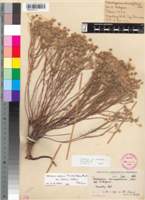Origin of name:
asper / -a / -um = rough
glabrum = smooth, hairless
Diagnostic characters:
Reduced, needle-like leaves
Compact growth form
Small compact heads
Beige bracts
Description:
Rounded, bushy shrublet up to c. 200 mm tall, main branches laxly corymbosely branched above, branches virgate, thinly white woolly-felted, closely leafy. Leaves patent or reflexed, 2�5 (�10) x 0,5 mm, scarcely smaller upwards, linear, margins strongly revolute, glabrous, glandular-punctate. Heads homogamous, c. 4 x 2 mm, cylindric, solitary or 2�4, very rarely more, together at the branch tips, closely surrounded by leaves. Involucral bracts in 5�6 series, outermost short, webbed with wool to surrounding leaves, inner subequal, equaling flowers, erect, tips semipellucid, subacute, often erose, either buff-coloured, sometimes with a reddish tinge, and pellucid, or subopaque to opaque white or dirty white, not radiating, soon caducous. Receptacle raised, slightly tuberculate. Flowers 7�13. Achenes not seen, ovaries with myxogenic duplex hairs. Pappus bristles many, equaling corolla, scabrid, bases with patent cilia not cohering.
Flowers mainly between December and March.
Distribution:
H. asperum var. glabrum grows on sandy soils, on grassy slopes or in fynbos, often near the sea; in Western and Eastern Cape, also on the mountains of the SW. Cape up to c. 600 m.
Fynbos, Thicket and Grassland Biomes.
Notes:
Differs from the typical plant in its lax, corymbosely arranged branches and many heads clustered at the tips of the branchlets.
Plants with buff-coloured bracts have been recorded from the Cape Peninsula; along the coast, east of Swellendam, plants begin to appear with subopaque, dirty-white tips to the involucral bracts, or occasionally the tips are opaque and pure white; plants with buff-coloured bracts are also present (Albertinia, Mossel Bay, Knysna, Kareedouw, Humansdorp, Uitenhage). Still further east (at Alexandria, Port Alfred, East London, Kei Mouth and Gogwana Mouth in the Eastern Cape) bract tips are mostly opaque white.
Specimens from Coombs Valley near Grahamstown may have woolly leaves as in var. appressifolium (Hilliard & Burtt 10852, E; K; NU; PRE) or glabrous leaves as in var. glabrum (Hilliard & Burtt 10863, E; K; NU; PRE); one plant of the latter collection has some branchlets with glabrous leaves, others with lower leaves glabrous, upper woolly.
Five varieties are recognized. Not all specimens can be assigned to a variety. Putative hybrids have been reported.
la Heads mostly solitary or 2�4 at the branch tips, rarely more:
2a Tips of involucral bracts light golden-brown, often tinged red, semi-pellucid
(a) var. asperum
2b Tips of involucral bracts opaque white
(b) var. albidulum
1b Heads several at the branch tips:
3a Leaves 2�5 (�10) x 0,5 mm, glabrous
(d) var. glabrum
3b Leaves either variously woolly at least when young, or if glabrous, then leaves mostly 7�10 x 1�1,5 mm:
4a Leaves mostly 7�20 x 1�1,5 mm, woolly or glabrous; tips of involucral bracts white
(e) var. comosum
4b Leaves mostly 3�6 x 0,5�1 mm:
5a Leaves loosely woolly; involucral bracts semipellucid, buff-coloured, sometimes with a reddish tinge
(c) var. appressifolium
5b Leaves enveloped in tightly woven 'tissue-paper' indumentum (though this breaks down to wool with age); tips of involucral bracts opaque white, often reddish above the stereome
(b) var. albidulum
Taxonomy:
Literature:
Helichrysum asperum (Thunb.) Hilliard & Burtt var. glabrum Hilliard & Burtt in Notes R. Bot. Gdn Edinb. 34: 79 (1975); Hilliard, Compositae in Natal 208 (1977).
Type:
Cape Peninsula, Wynberg Hill, 19 i 1919, Pillans 3279 (PRE, holo.).
Synonym(s):
Vouchers:
Esterhuysen 418 (BOL; PRE); Flanagan 336 (PRE); Hilliard & Burtt 10896 (E; K; MO; NU; PRE; S).


